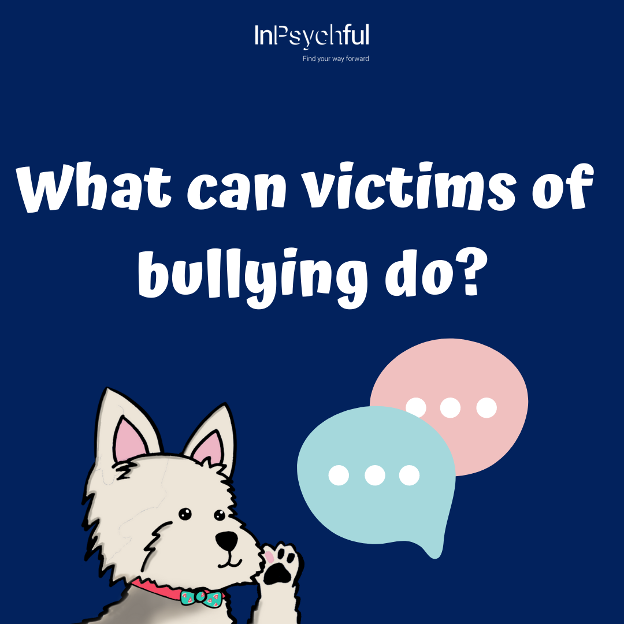How common is bullying at workspace?
Singapore has one of the highest levels of workplace bullying, according to a Kantar survey (Ng, 2020). Shockingly, in 2020, it is reported that almost one in four employees in Singapore have felt bullied, undermined and harassed (Ng, 2020). Considering that bullying is a scary and confusing experience, it is probable that many remain silent about their situation.
How do I know that what I am experiencing, or witnessing is bullying?
There are times when we may ask ourselves, is this strict management or is this crossing the line towards bullying? The Tripartite Alliance for Fair & Progressive Employment Practices (“TAFEP”) states that when a person in the workplace distresses, alarms or harasses another party with his or her behaviour, that is considered as bullying (TAFEP, 2019).
Workplace bullying occurs in multitudes of ways and can be initiated by different people within the workspace. This can include bosses, colleagues, managers and customers (Ng, 2020). Bullying may come in the form of spreading rumours and gossiping about the victim, and despising and isolating the victim (Chin, 2019). One may feel constantly criticised or have responsibilities taken away without proper explanation. Some one may be displaying aggressive behaviour and threats or continuously putting the target down (Bullying UK, 2021). One may also be ignored, have their concerns or feelings minimised .As you may have realised, workplace bullying can range from subtle to more direct forms.
Such harassment can occur in different situations, even outside the office, such as business trips and client’s area or any other work-related situations. This can happen when individuals are in the same space, or even through emails, messaging and on social media.
Why does it occur?
Factors such as job insecurity, role ambiguity, and cognitive demands from the job may be linked to bullying. Supervisors may have a lack of training in handling particular situations and may experience difficulties trying to communicate with the staff (Chin, 2019). The bullies may also have been a victim of bullying in the past, as a newer staff and feels that he or she could treat the new staff in the same fashion (Chin, 2019). The busy work environment locally may also contribute to this occurrence (Chin, 2019).
A major explanation of bullying is personality factors. Some of us may have heard of the “Big 5” personality trait, which includes openness, conscientiousness, agreeableness, extraversion, and neuroticism. In particular, it was found that bullies were rated much lower in agreeableness compared to targets and the control.
Neuroticism is a trait that includes sadness, feeling moody and being emotionally unstable. According to Mitsopoulou and Giovazolias (2015), it was found that neuroticism is associated with victimisation, and this could be due to how neuroticism is linked to behaviours that may be irritating and troublesome to others and thus leading to unpleasant responses from colleagues (Milam et al., 2009).
Another personality trait that is found to be related to victimisation is extroversion. The victim is rated lower on extraversion than the bully and control (Pallesen et al., 2017). Individuals scoring low in extraversion tended to receive less social support (Swickert et al., 2002) which increases the likelihood of becoming targets of bullying.
What effects can it have on individuals?
At the individual level, bullying leads to the employees and witnesses having a lower self-esteem and job satisfaction. As a result, victims of bullying may have mental health related repercussions. For instance, victims may experience depression, anxiety disorder or trauma (Chin, 2019). Bullying can affect the sense of value and self, which has a knock-on effect on other areas in the victim’s lives (Chin, 2019). Workers who experienced bullying may also feel a lack of confidence, feel exhaustion and at times sense of worthlessness (Ng, 2020). This may in turn lead to effects on their sleep and eating cycles, which impacts their relationships with friends and family (Chin, 2019).
From a broader perspective, companies may experience lower work productivity and quality, a decline in engagement with workers and drop in reputation (Curry, 2018). They may also see an increase in employees missing workdays, turnovers and claims for compensation (Curry, 2018).
What can victims of bullying do?
If one feels that he or she is being bullied at work, one can take some of the following steps (Ng, 2019):
- Gather information related to the bullying situation, but do so carefully and discreetly, to avoid other unintended reactions from others.
- Understand the employment contract well, check one’s contract to establish whether one is tasked to do beyond the contract.
- If one has sufficient information to prove their situation, victims can speak up about the situation and inform the Human Resources department or manager about this but remain objective and honest in this process.
- Should the situation remain status quo, one may consider reaching out to the Ministry of Manpower, or the Tripartite Alliance for Fair and Progressive Employment Practices.
- Seek support from friends and family members and talk about one’s thoughts and feelings regarding one’s situation.
- If the victim feels that this issue has affected his or her mental health and life significantly, do seek professional support like a psychologist for support!
If you have put in your best efforts at work, you would not have to worry about your abilities. Prioritise your well-being and leave the company if the situation does not improve further (Ng, 2019).
It can be highly distressing to be a victim of bullying and we hope to shed some light on this prevalent situation that you or your colleagues may be experiencing. If you are a victim of bullying, we hope that this article can provide a way for you to navigate in your situation. If you are witnessing forms of bullying at the workplace, do reach out to your colleagues and determine if you can assist him or her in any ways.
Camellia Wong, MA., Tan Khai Teng
Reference
Ng, S.C. (2020, September 15). Dealing with workplace bullies. Lexicon. https://smulexicon.com/2020/09/15/dealing-with-workplace-bullies/
Kantar (2019, 16 September). Most inclusive countries and countries identified in new Kantar inclusion index. https://www.kantar.com/company-news/InclusionIndex>
Curry, L. (2018, January) Bully be gone: What is workplace bullying and why does it matter? Institutional Knowledge at Singapore Management University. https://ink.library.smu.edu.sg/cgi/viewcontent.cgi?article=1130&context=lien_research
Chin, N. (2019, January 17). Bullied at work? Here’s what you can do. The Pride. https://pride.kindness.sg/bullied-at-work-heres-what-you-can-do/
Tripartite Alliance for Fair & Progressive Employment Practices (2019). About Workplace Harassment. https://www.tal.sg/tafep/Employment-Practices/Workplace-Harassment/About#
Pallesen, S., Nielsen, M. B., Magerøy, N., Andreassen, C. S., & Einarsen, S. (2017). An experimental study on the attribution of personality traits to bullies and targets in a workplace setting. Frontiers in Psychology, 8, 1045. https://doi.org/10.3389/fpsyg.2017.01045
Mitsopoulou, E., & Giovazolias, T. (2015). Personality traits, empathy and bullying behavior: A meta-analytic approach. Aggression and violent behavior, 21, 61-72.
Milam, A. C., Spitzmueller, C., & Penney, L. M. (2009). Investigating individual differences among targets of workplace incivility. Journal of occupational health psychology, 14(1), 58.
Swickert, R. J., Rosentreter, C. J., Hittner, J. B., & Mushrush, J. E. (2002). Extraversion, social support processes, and stress. Personality and Individual Differences, 32(5), 877-891.
Bullying UK (2021, August 21). The signs of workplace bullying. https://www.bullying.co.uk/bullying-at-work/the-signs-of-workplace-bullying/
ERC (2013, November 5). 20 Subtle Signs of Bullying at Work https://www.yourerc.com/blog/post/20-Subtle-Signs-of-Workplace-Bullying



